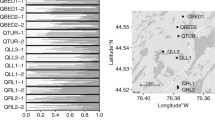Summary
One possible consequence of low population density, particularly in self-incompatible plants, is reproductive failure. I surveyed seed set per flower in two populations of the self-incompatible annual Diplotaxis erucoides (Brassicaceae) in Jerusalem, Israel. Widely spaced plants had lower fruit set and fewer seeds per filled silique than did plants growing close to conspecific neighbors. Such density-dependent reproductive success could help explain the maintanence of spatial patchiness in plant populations, and could also have implications for population dynamics of rare species.
Similar content being viewed by others
References
Allee WC (1951) The social life of animals, 2 Edition. Beacon Press Boston, 1958 reprint under original title
Allee WC, Emerson AE, Park O, Park T, Schmidt KP (1949) Principles of animal ecology. W.B. Saunders Company Philadelphia
Allison TD (1990) Pollen production and plant density affect pollination and seed production in Taxus canadensis. Ecology 71:516–522
Bawa KS, Beach M (1981) Evolution of sexual systems in flowering plants. Ann Missouri Bot Gard 68:254–274
Ellner S, Shmida A (1981) Why are adaptations for long-range dispersal rare in desert plants? Oecologia 51:133–144
Feinsinger P, Murray KG, Kinsman S, Busby WH (1986) Floral neighborhood and pollination success in four hummingbrid-pollinated cloud forest plant species. Ecology 67:449–464
Feinsinger P, Tiebout HM III, Young BE (1991) Do tropical birdpollinated plants exhibit density-dependent interactions? Field experiments. Ecology 72:1953–1963
Hamilton WD, May RM (1977) Dispersal in stable habitats. Nature 269:578–581
Heithaus ER, Stashko E, Anderson PK (1982) Cumulative effects of plant-animal interactions on seed production by Bauhinia ungulata, a neotropical legume. Ecology 63:1294–1302
Hirrel MC, Mehravaran H, Gerdemann JW (1978) Vesicular-arbuscular mycorrhizae in the Chenopodiaceae and Cruciferae: do they occur? Can J Bot 56:2813–2817
Kunin WE (1991) Few and far between: plant population density and its effects on insect-plant interactions. Ph. D. Thesis. University of Washington
Lack D (1954) The natural regulation of animal numbers. Oxford University Press New York
Lewontin RC, Levins R (1989) On the characterization of density and resource availability. Am Nat 134:513–524
Nicholson AJ (1933) The balance of animal populations. J Anim Ecol 2:132–178
Nicholson AJ (1957) The self-adjustment of populations to change. Cold Spring Harbor Symp Quant Biol 22:153–173
Platt WJ, Hill GR, Clark S (1974) Seed production in a prairie legume (Astragalus canadensis L.): interactions between pollination, predispersal seed predation, and plant density. Oecologia 17:55–63
Shields WM (1982) Philopatry, inbreeding, and the evolution of sex. State University of New York Press Albany, NY
Silander JW (1978) Density-dependent control of reproductive success in Cassia biflora. Biotropica 10:292–296
Smith HS (1935) The role of biotic factors in the determination of population densities. J Econ Entomol 34:1–12
Zohary M (1966) Flora Palaestina; Part 1: Equisetaceae to Moringaceae. The Israel Academy of Sciences and Humanities Jerusalem
Author information
Authors and Affiliations
Rights and permissions
About this article
Cite this article
Kunin, W.E. Density and reproductive success in wild populations of Diplotaxis erucoides (Brassicaceae). Oecologia 91, 129–133 (1992). https://doi.org/10.1007/BF00317251
Received:
Accepted:
Issue Date:
DOI: https://doi.org/10.1007/BF00317251




